A journey through time awaits as we explore the fascinating and storied history of Montana‘s Old West! Picture a land of vast open plains, rugged mountains, and untamed wilderness—the perfect setting for adventure and discovery. It’s a place where fortune seekers, outlaws, and hardworking folks once carved out a life in the untamed American West.
As we embark on this adventure, we’ll uncover the stories behind seven incredible ghost towns scattered across Montana’s breathtaking landscape.

So, what exactly is a ghost town?
It’s a once-thriving settlement that was abandoned due to various reasons, such as the decline of mining or other industries. So these towns, which now stand eerily quiet and empty, serve as a testament to the passing nature of prosperity and the relentless passage of time.
In this article, we’ll explore how Montana’s bustling mining industry led to the birth and eventual demise of these towns, each with its unique history and character.
Let’s hit the dusty trail and see what fascinating tales and intriguing mysteries await us!
#1: Bannack
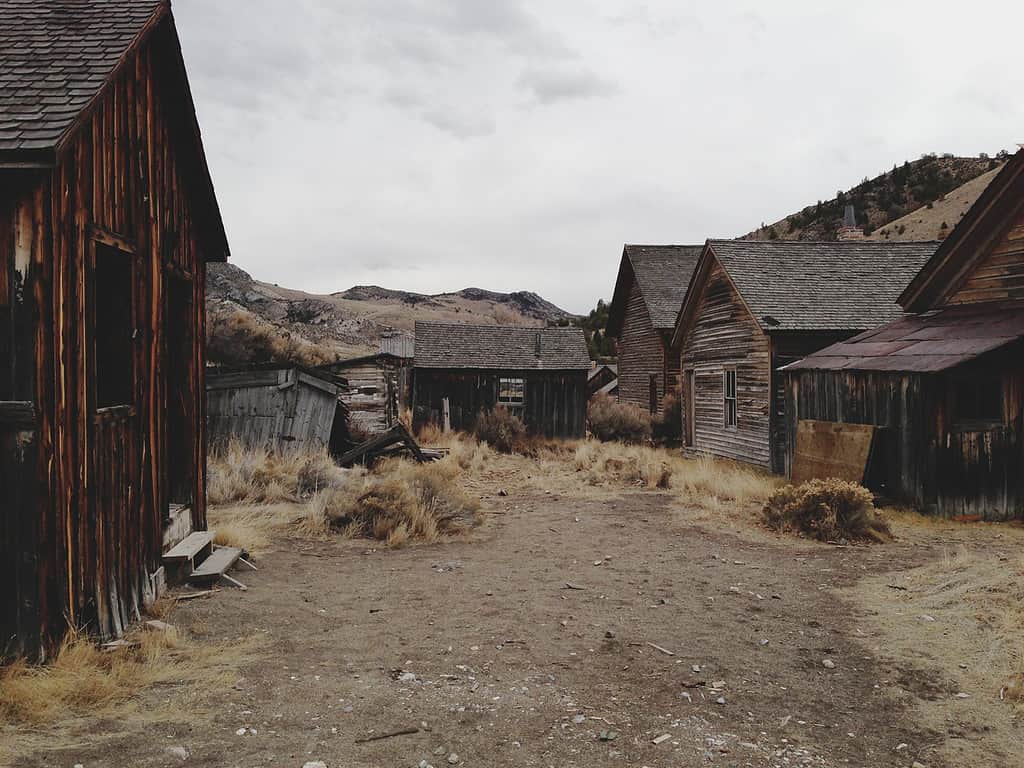
Bannack used to be a town of 10,000 residents but is now one of the ghost towns of Montana.
©iStock.com/kevinruss
Bannack, our first stop on this journey through Montana’s ghost towns, is a true gem of the Old West. Founded in 1862 after gold was discovered along Grasshopper Creek, Bannack quickly became a bustling mining town, attracting prospectors and pioneers from all over the country. At its peak, the town boasted a population of around 10,000 residents, all seeking their fortune in the gold rush.
History and Significance
Bannack played a significant role in Montana’s early history, serving as the first territorial capital from 1864 to 1865. It was also the birthplace of the infamous Montana Vigilantes. This was a group of citizens who took the law into their own hands to bring justice to the lawless frontier.
Over time, as gold deposits dwindled and the capital moved to Virginia City, Bannack’s population gradually declined, eventually turning the once-thriving town into a ghostly relic.
Key Attractions and Structures
Today, Bannack stands as a beautifully preserved state park. The park offers visitors a unique opportunity to explore over 60 historic structures.
- Hotel Meade. The iconic Hotel Meade, once a bustling hub of activity, now stands silent but still impressive in its grandeur.
- Skinner’s Saloon. Another must-see attraction is the Skinner’s Saloon, where the legendary Sheriff Henry Plummer once held court before meeting his end at the hands of the Montana Vigilantes.
- Bannack Cemetery. And don’t forget to visit the Bannack Cemetery, a somber reminder of the hardships faced by the town’s early inhabitants.
#2: Garnet
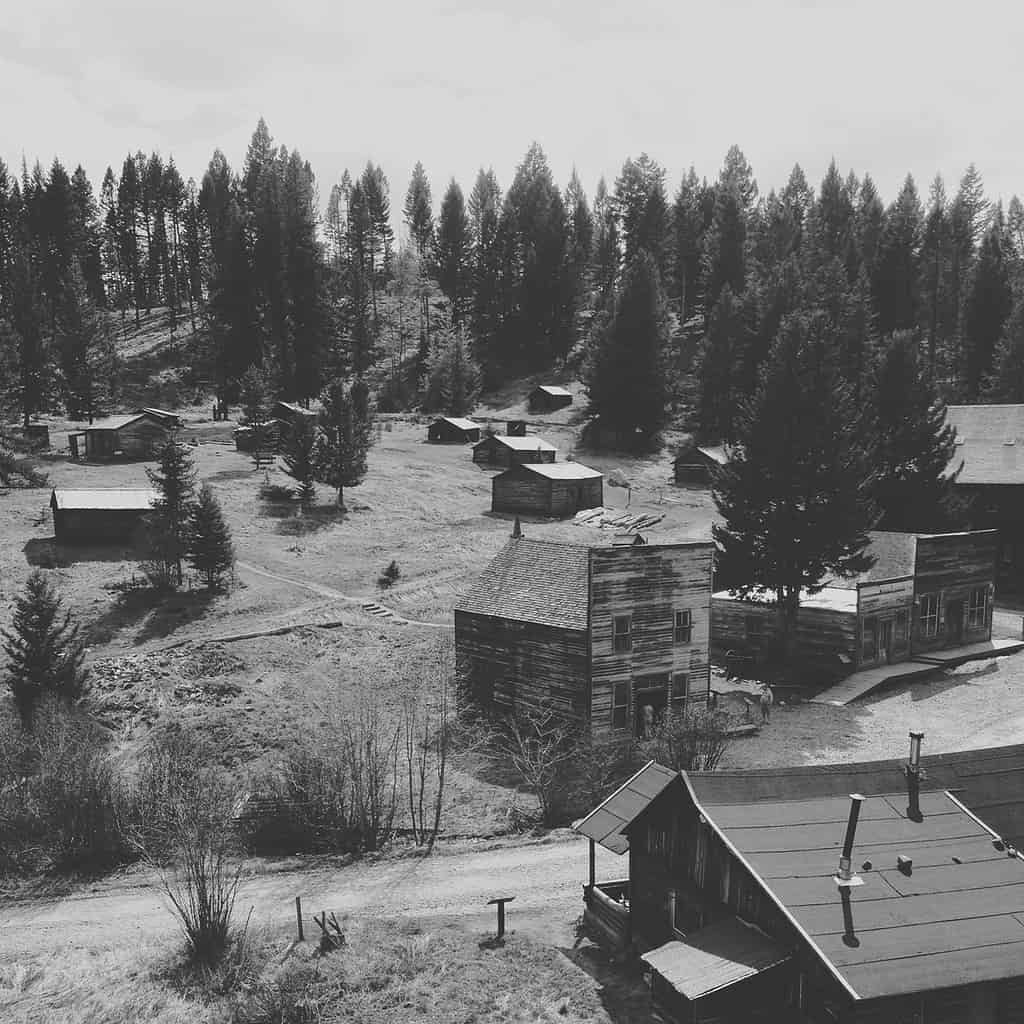
Garnet was a mining town and home to 1,000 residents.
©iStock.com/kevinruss
Next, on our ghost town journey, we venture to Garnet, a hidden treasure tucked away in the mountains of western Montana. Established in 1895 as a gold-mining town, Garnet’s rich history and well-preserved buildings offer a captivating look into the lives of those who called this remote outpost home during the height of the mining boom.
History and Significance
Garnet’s story began with the discovery of gold in the surrounding mountains. As prospectors and miners flocked to the area, the town quickly grew, complete with saloons, stores, hotels, and even a school.
At its peak, Garnet was home to about 1,000 residents. However, like many other mining towns, Garnet’s fortune was short-lived. By the early 1900s, the gold deposits began to dwindle. A devastating fire in 1912 hastened the town’s decline. The once-bustling settlement was soon left to the mercy of time and the elements.
Key Attractions and Structures
Today, Garnet is a true treasure for history enthusiasts, with many of its original structures still standing.
- J.K. Wells Hotel. The J.K. Wells Hotel, with its faded wallpaper and creaking floorboards, offers a glimpse into the accommodations of the time.
- Davey’s Store and Dr. Kelley’s Drug Store. The Davey’s Store and Dr. Kelley’s Drug Store showcase the goods and services that were available to the town’s residents during its heyday.
As you wander the streets of Garnet, you’ll also find the remnants of residential homes, the blacksmith’s shop, and even the old assay office, where miners would have brought their ore to determine its gold content.
#3: Comet
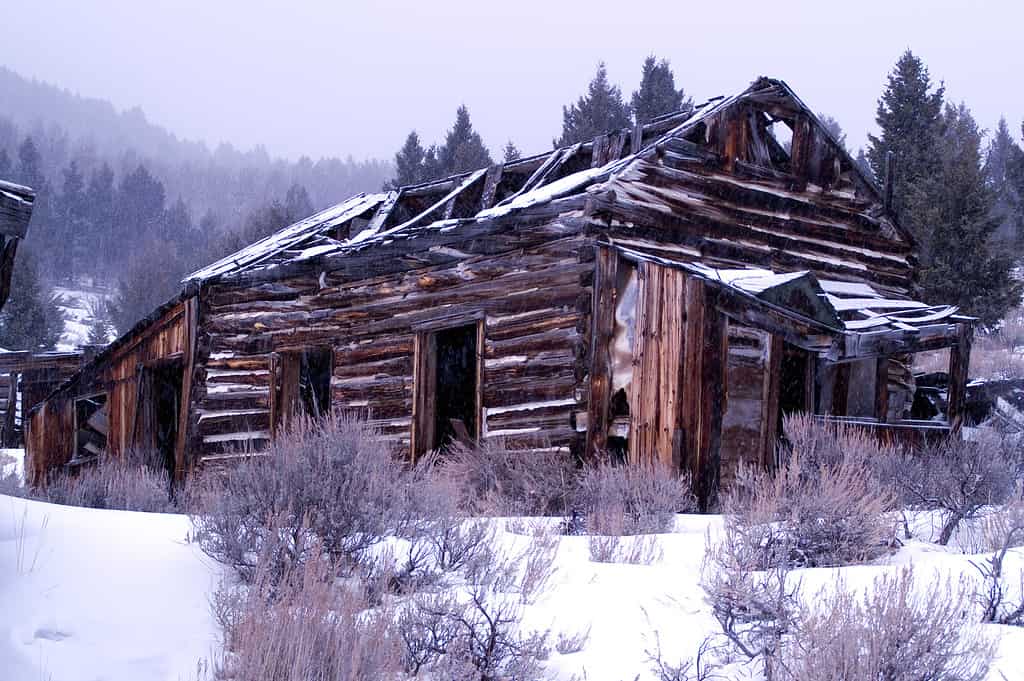
In its prime, Comet was a mining town with a population of 300. It also boasted 22 saloons.
©iStock.com/suesmith2
Comet is a once-thriving mining town nestled in the Boulder Valley. Established in the late 1800s, Comet’s rich deposits of gold, silver, and lead brought miners and their families to this rugged, remote corner of the state.
While its heyday was short-lived, the well-preserved remains of Comet offer an intriguing look into the lives of those who dared to chase their dreams in the heart of the Montana wilderness.
History and Significance
Comet’s history began with the discovery of valuable minerals in the area. This led to the establishment of the Comet Mine in 1883. After that, the town grew rapidly, boasting a population of around 300 residents at its peak. Comet featured various businesses, including a post office, a general store, and even a two-story schoolhouse.
Unfortunately, as the mines began to run dry and the price of metals declined, the town’s prosperity waned. By the 1940s, Comet was all but abandoned, leaving only the echoes of its past behind.
Key Attractions and Structures
Visiting Comet today is like stepping back in time. This is because so many of the town’s original structures remain standing. As a result, they offer a rare glimpse into the daily life of a mining community.
- Comet Mill. The impressive ruins of the Comet Mill, with its towering stone walls, bear witness to the industrial might that once fueled the town’s economy.
- General Store. The former general store, with its shelves still stocked with dusty cans and bottles, serves as a poignant reminder of the people who once called Comet home.
The town has the remnants of various residential buildings, workshops, and other structures that make up this once-thriving community. Each crumbling facade tells a story of the dreams, struggles, and eventual decline of a town built on the promise of mineral wealth.
#4: Granite
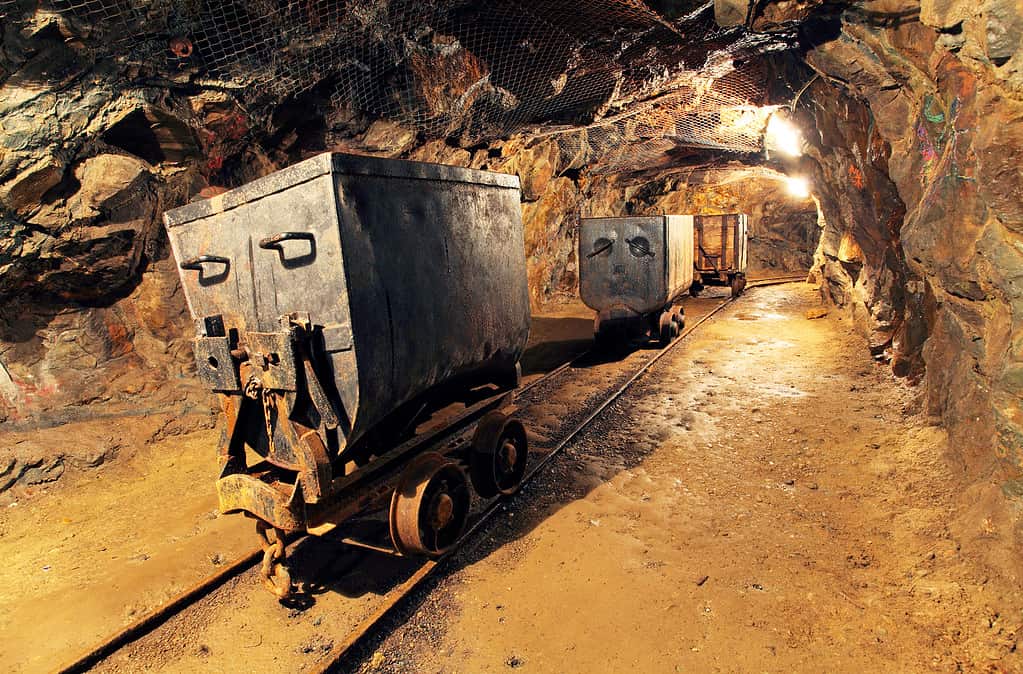
Granite was once a thriving mining town but is now one of the ghost towns in Montana.
©TTstudio/Shutterstock.com
Granite is a once-thriving silver mining town perched high in the mountains of southwestern Montana. Founded in the late 19th century, Granite was a testament to the determination and ingenuity of the miners who carved a bustling community out of the rugged, unforgiving landscape. Today, the remnants of Granite offer a haunting and fascinating look into the past.
History and Significance
The story of Granite began in 1872 with the discovery of a rich silver vein in the area. As word spread, miners flocked to the mountains, and the town of Granite was born. At its peak, Granite was home to more than 3,000 residents. The Granite Mountain Mine became one of the largest silver producers in the world.
However, as silver prices plummeted and the mines were exhausted, the town’s fortunes faded. By the early 20th century, Granite was largely abandoned, leaving only the ghosts of its former glory behind.
Key Attractions and Structures
Today, the remains of Granite offer a fascinating glimpse into the lives of the miners and their families who once called this remote outpost home.
- Granite Mountain Mine. The massive, crumbling ruins of the Granite Mountain Mine still dominate the landscape, providing a testament to the industrial might that once powered the town’s economy.
- Miners’ Union Hall. Granite has the remnants of the town’s residential and commercial buildings, including the Miners’ Union Hall, which served as a social hub for the community.
- Old Schoolhouse. The old schoolhouse, with its broken windows and sagging roof, stands as a poignant reminder of the children who were raised in this isolated mountain town.
#5: Coloma

Coloma was a gold mining town in Montana in the late 19th century.
©Linda Roberts/Shutterstock.com
Our next destination in the journey through Montana’s ghost towns is Coloma, a lesser-known but equally captivating gold mining town nestled in the mountains of the Garnet Range. Established in the 1890s, Coloma was a relatively small but vibrant community that attracted miners and their families to the promise of a fortune hidden beneath the rugged terrain. Today, the remnants of Coloma offer a window into the lives of those who braved the challenges of this remote mountain town.
History and Significance
Coloma’s beginnings trace back to the discovery of gold in the surrounding mountains in the late 19th century. The town quickly sprouted up, complete with a post office, saloons, stores, and cabins for the miners and their families. Although Coloma never reached the same scale as some of its more famous neighbors, it was a bustling community at its peak, with around 500 residents. However, as the gold deposits were exhausted and the town’s prosperity waned, Coloma was gradually abandoned, leaving only the vestiges of its past behind.
Key Attractions and Structures
Today, visitors to Coloma can explore the remnants of the town’s historic buildings. They offer a fascinating glimpse into the daily life of a small mining community.
- Old general store. Among the key attractions are the old general store, with its broken windows and weathered façade.
- Miners’ Cabin. The Miner’s Cabin, a small log structure, once provided shelter for the hardworking prospectors.
As you wander through the overgrown streets of Coloma, you’ll also discover the remains of various other structures, such as the blacksmith’s shop and the assay office. They played essential roles in the town’s mining operations. The scattered remnants of Coloma paint a vivid picture of a once-thriving community that now lies in silent repose.
#6: Castle Town
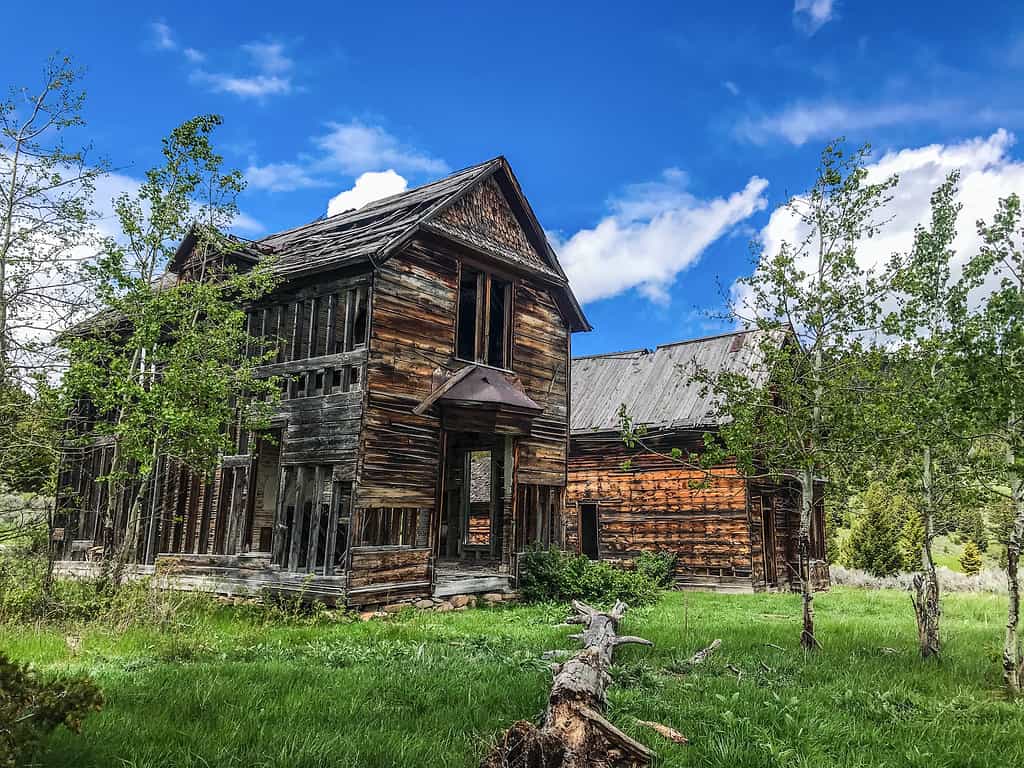
Castle Town in Montana began in 1882 and became one of the ghost towns in Montana by the early 20th century.
©cendrine chenel/Shutterstock.com
As we continue our journey through Montana’s ghost towns, we come across Castle Town, a once-thriving mining community that sprang up in the heart of the Castle Mountains. Founded in the late 19th century, Castle Town was built on the promise of silver and lead deposits that lured miners and their families to this rugged, remote region. Today, the remnants of Castle Town offer a haunting and evocative glimpse into the lives of those who once called this windswept outpost home.
History and Significance
Castle Town’s story began in 1882 with the discovery of silver and lead deposits in the surrounding mountains. The town quickly grew. At its peak, Castle Town was home to over 2,000 residents, complete with a bustling main street lined with saloons, stores, and hotels.
However, as the mines began to run dry and the price of silver declined, the town’s fortunes faded. By the early 20th century, Castle Town was largely abandoned, leaving only the ghosts of its past behind.
Key Attractions and Structures
Visiting Castle Town today is like stepping back in time. This is because so many of the town’s original structures still stand. They offer a rare glimpse into the daily life of a mining community.
- Northumberland Mine. The impressive stone ruins of the Northumberland Mine still tower over the landscape, bearing witness to the industrial might that once fueled the town’s economy.
- Miner’s Union Hall and Old Schoolhouse. In Castle Town, you’ll also find the remnants of the Miner’s Union Hall, the old schoolhouse, and various residential buildings that once housed the miners and their families.
These well-preserved structures provide a fascinating window into the lives of those who braved the challenges of the Montana wilderness in search of fortune and a better life.
#7: Coolidge
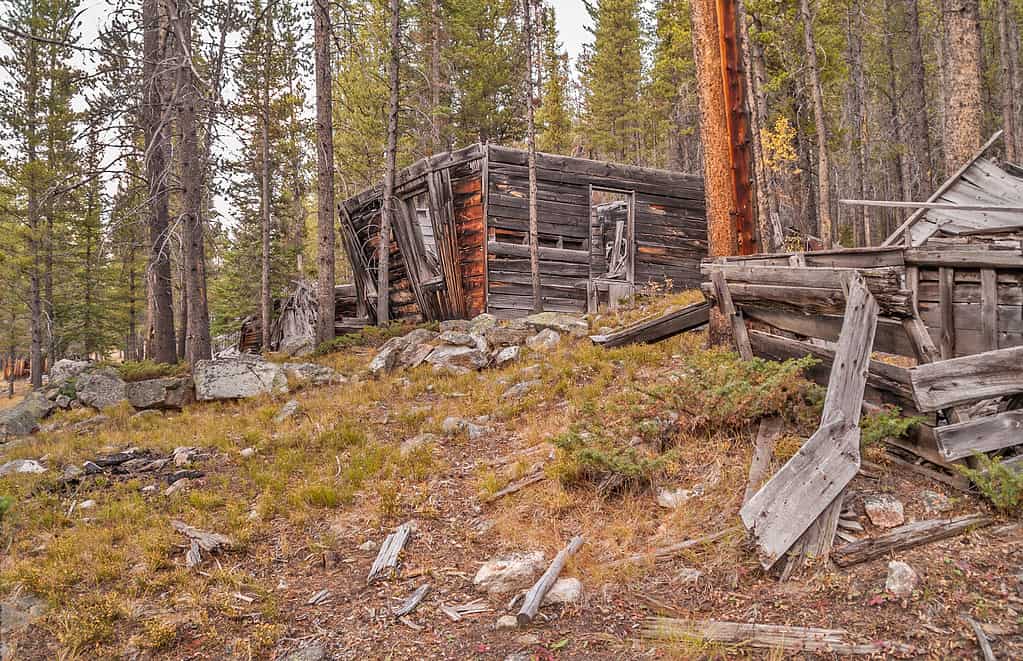
Abandoned and neglected buildings in Coolidge, Montana.
©iStock.com/
As we venture further into the realm of Montana’s ghost towns, we discover Coolidge, a lesser-known but equally fascinating silver mining town tucked away in the Pioneer Mountains. Established in the early 20th century, Coolidge was built on the promise of rich silver deposits that drew miners and their families to this remote and picturesque corner of Montana. Today, the remnants of Coolidge offer a unique and haunting insight into the lives of those who once called this isolated community home.
History and Significance
Coolidge’s origins can be traced back to the early 1900s when silver was discovered in the surrounding mountains. With the development of the Elkhorn and Upper Elkhorn mines, the town of Coolidge was born. At its peak, Coolidge was home to around 300 residents, complete with a post office, general store, and other essential amenities.
However, as the silver deposits dwindled and the Great Depression took its toll, the town’s prosperity waned. By the mid-20th century, Coolidge was all but abandoned, leaving only the echoes of its past behind.
Key Attractions and Structures
Visiting Coolidge today offers a fascinating look into the lives of the miners and their families who once called this remote outpost home. The massive, now-silent mill still dominates the landscape, serving as a testament to the industry that once powered the town’s economy.
As you explore Coolidge’s deserted streets, you’ll discover the remnants of various residential and commercial buildings, including:
- The old general store with its shelves still lined with dusty cans and bottles
- The former post office, with its weathered facade and broken windows.
These stand as poignant reminders of the once-thriving community that has now faded into history.
Key Takeaways
As our journey through Montana’s Old West ghost towns comes to a close, it’s clear that these forgotten corners of the American frontier have left an indelible mark on history. Each town we’ve explored offers a unique glimpse into the lives of the people who braved the challenges of this untamed land in pursuit of their dreams.
The importance of preserving these ghost towns cannot be overstated. They serve as a window into the past. They also provide valuable lessons about resilience, determination, and the ever-changing nature of progress.
Visiting these historic locations offers an experience unlike any other. Walking down the silent streets, it’s easy to imagine the bustling activity that once filled these now-abandoned settlements.
Summary Of 7 Old West Ghost Towns Found In Montana
| Rank | Ghost Town |
|---|---|
| 1 | Bannack |
| 2 | Garnet |
| 3 | Comet |
| 4 | Granite |
| 5 | Coloma |
| 6 | Castle Town |
| 7 | Coolidge |
The photo featured at the top of this post is © iStock.com/Mantas Volungevicius
Thank you for reading! Have some feedback for us? Contact the AZ Animals editorial team.







